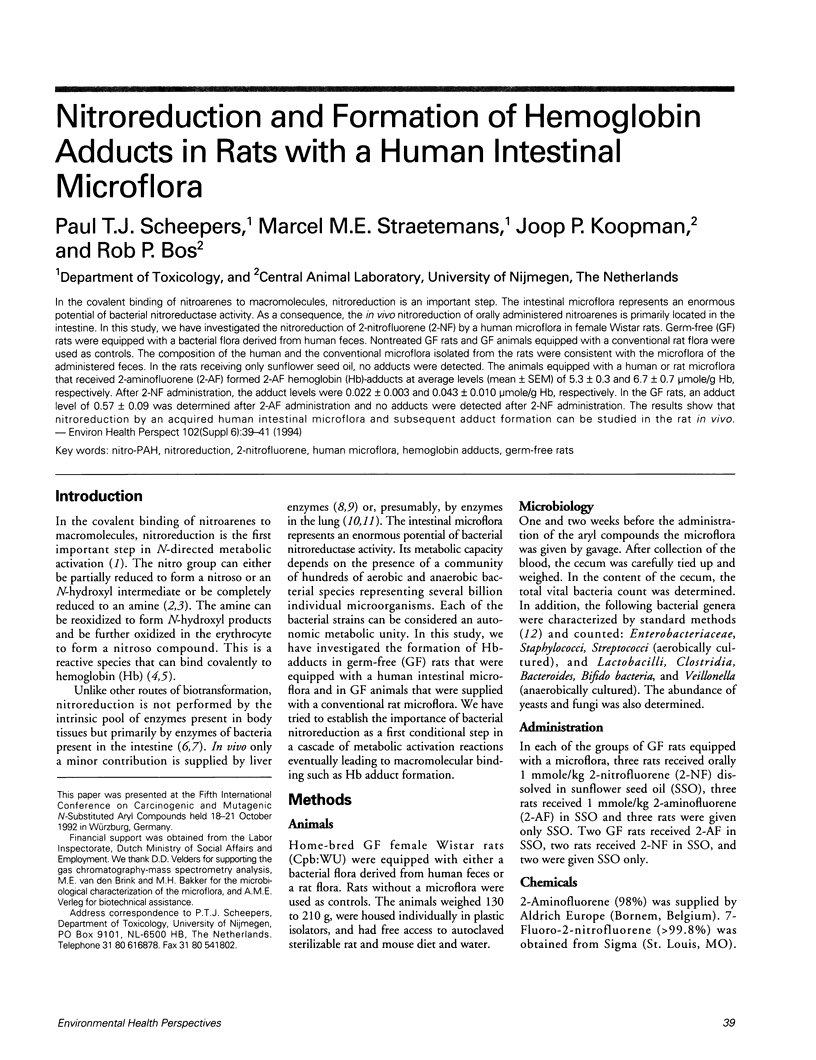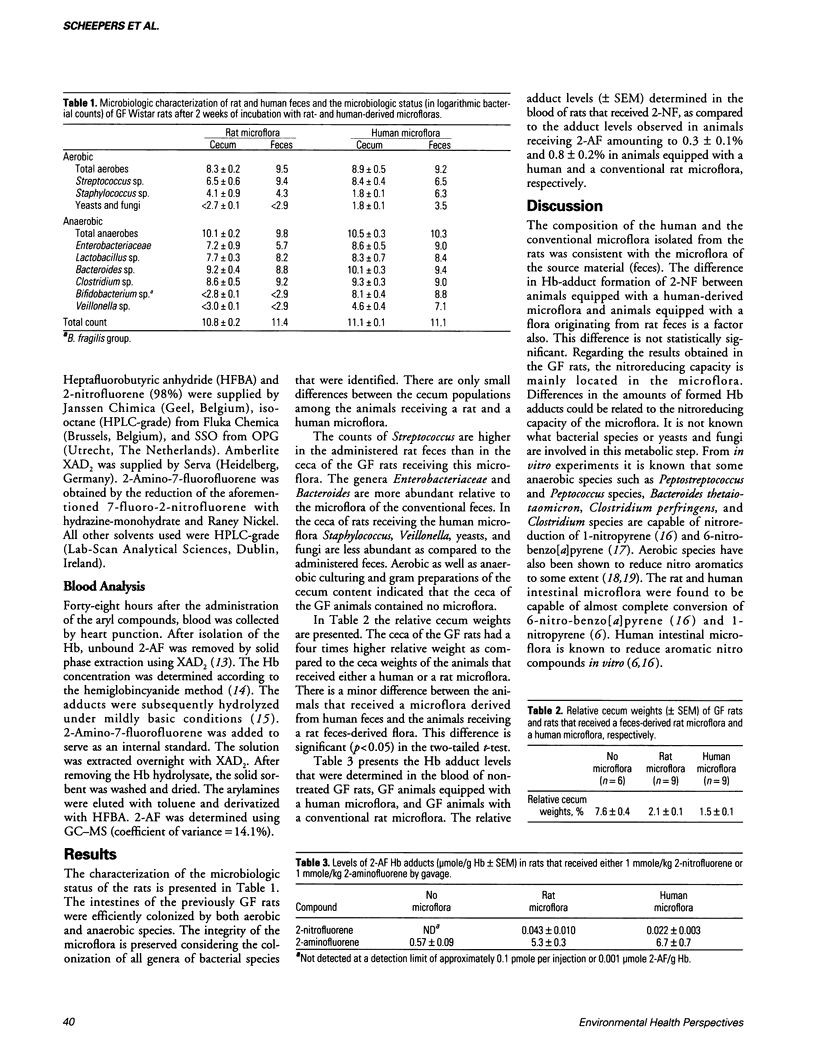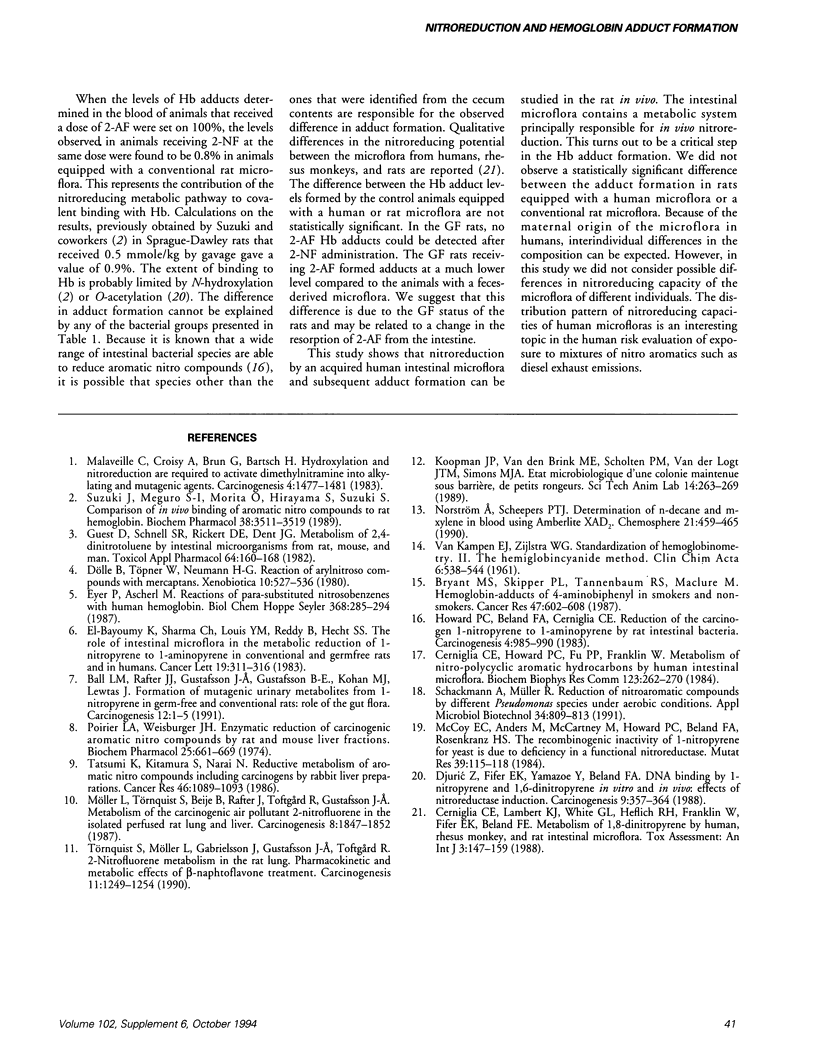Abstract
In the covalent binding of nitroarenes to macromolecules, nitroreduction is an important step. The intestinal microflora represents an enormous potential of bacterial nitroreductase activity. As a consequence, the in vivo nitroreduction of orally administered nitroarenes is primarily located in the intestine. In this study, we have investigated the nitroreduction of 2-nitrofluorene (2-NF) by a human microflora in female Wistar rats. Germ-free (GF) rats were equipped with a bacterial flora derived from human feces. Nontreated GF rats and GF animals equipped with a conventional rat flora were used as controls. The composition of the human and the conventional microflora isolated from the rats were consistent with the microflora of the administered feces. In the rats receiving only sunflower seed oil, no adducts were detected. The animals equipped with a human or rat microflora that received 2-aminofluorene (2-AF) formed 2-AF hemoglobin (Hb)-adducts at average levels (mean +/- SEM) of 5.3 +/- 0.3 and 6.7 +/- 0.7 mumole/g Hb, respectively. After 2-NF administration, the adduct levels were 0.022 +/- 0.003 and 0.043 +/- 0.010 mumole/g Hb, respectively. In the GF rats, an adduct level of 0.57 +/- 0.09 was determined after 2-AF administration and no adducts were detected after 2-NF administration. The results show that nitroreduction by an acquired human intestinal microflora and subsequent adduct formation can be studied in the rat in vivo.
Full text
PDF


Selected References
These references are in PubMed. This may not be the complete list of references from this article.
- Bryant M. S., Skipper P. L., Tannenbaum S. R., Maclure M. Hemoglobin adducts of 4-aminobiphenyl in smokers and nonsmokers. Cancer Res. 1987 Jan 15;47(2):602–608. [PubMed] [Google Scholar]
- Cerniglia C. E., Howard P. C., Fu P. P., Franklin W. Metabolism of nitropolycyclic aromatic hydrocarbons by human intestinal microflora. Biochem Biophys Res Commun. 1984 Aug 30;123(1):262–270. doi: 10.1016/0006-291x(84)90407-8. [DOI] [PubMed] [Google Scholar]
- Djurić Z., Fifer E. K., Yamazoe Y., Beland F. A. DNA binding by 1-nitropyrene and 1,6-dinitropyrene in vitro and in vivo: effects of nitroreductase induction. Carcinogenesis. 1988 Mar;9(3):357–364. doi: 10.1093/carcin/9.3.357. [DOI] [PubMed] [Google Scholar]
- Dölle B., Töpner W., Neumann H. G. Reaction of arylnitroso compounds with mercaptans. Xenobiotica. 1980 Jul-Aug;10(7-8):527–536. doi: 10.3109/00498258009033787. [DOI] [PubMed] [Google Scholar]
- El-Bayoumy K., Sharma C., Louis Y. M., Reddy B., Hecht S. S. The role of intestinal microflora in the metabolic reduction of 1-nitropyrene to 1-aminopyrene in conventional and germfree rats and in humans. Cancer Lett. 1983 Jul;19(3):311–316. doi: 10.1016/0304-3835(83)90100-3. [DOI] [PubMed] [Google Scholar]
- Eyer P., Ascherl M. Reactions of para-substituted nitrosobenzenes with human hemoglobin. Biol Chem Hoppe Seyler. 1987 Mar;368(3):285–294. doi: 10.1515/bchm3.1987.368.1.285. [DOI] [PubMed] [Google Scholar]
- Guest D., Schnell S. R., Rickert D. E., Dent J. G. Metabolism of 2,4-dinitrotoluene by intestinal microorganisms from rat, mouse, and man. Toxicol Appl Pharmacol. 1982 Jun 15;64(1):160–168. doi: 10.1016/0041-008x(82)90335-0. [DOI] [PubMed] [Google Scholar]
- Howard P. C., Beland F. A., Cerniglia C. E. Reduction of the carcinogen 1-nitropyrene to 1-aminopyrene by rat intestinal bacteria. Carcinogenesis. 1983 Aug;4(8):985–990. doi: 10.1093/carcin/4.8.985. [DOI] [PubMed] [Google Scholar]
- Malaveille C., Croisy A., Brun G., Bartsch H. Hydroxylation and nitroreduction are required to activate dimethylnitramine into alkylating and mutagenic agents. Carcinogenesis. 1983 Nov;4(11):1477–1481. doi: 10.1093/carcin/4.11.1477. [DOI] [PubMed] [Google Scholar]
- McCoy E. C., Anders M., McCartney M., Howard P. C., Beland F. A., Rosenkranz H. S. The recombinogenic inactivity of 1-nitropyrene for yeast is due to a deficiency in a functional nitroreductase. Mutat Res. 1984 Mar;139(3):115–118. doi: 10.1016/0165-7992(84)90004-6. [DOI] [PubMed] [Google Scholar]
- Möller L., Törnquist S., Beije B., Rafter J., Toftgård R., Gustafsson J. A. Metabolism of the carcinogenic air pollutant 2-nitrofluorene in the isolated perfused rat lung and liver. Carcinogenesis. 1987 Dec;8(12):1847–1852. doi: 10.1093/carcin/8.12.1847. [DOI] [PubMed] [Google Scholar]
- Poirier L. A., Weisburger J. H. Enzymic reduction of carcinogenic aromatic nitro compounds by rat and mouse liver fractions. Biochem Pharmacol. 1974 Feb 1;23(3):661–669. doi: 10.1016/0006-2952(74)90631-5. [DOI] [PubMed] [Google Scholar]
- Suzuki J., Meguro S., Morita O., Hirayama S., Suzuki S. Comparison of in vivo binding of aromatic nitro and amino compounds to rat hemoglobin. Biochem Pharmacol. 1989 Oct 15;38(20):3511–3519. doi: 10.1016/0006-2952(89)90122-6. [DOI] [PubMed] [Google Scholar]
- Tatsumi K., Kitamura S., Narai N. Reductive metabolism of aromatic nitro compounds including carcinogens by rabbit liver preparations. Cancer Res. 1986 Mar;46(3):1089–1093. [PubMed] [Google Scholar]
- Törnquist S., Möller L., Gabrielsson J., Gustafsson J. A., Toftgård R. 2-Nitrofluorene metabolism in the rat lung. Pharmacokinetic and metabolic effects of beta-naphthoflavone treatment. Carcinogenesis. 1990 Aug;11(8):1249–1254. doi: 10.1093/carcin/11.8.1249. [DOI] [PubMed] [Google Scholar]
- van KAMPEN E., ZIJLSTRA W. G. Standardization of hemoglobinometry. II. The hemiglobincyanide method. Clin Chim Acta. 1961 Jul;6:538–544. doi: 10.1016/0009-8981(61)90145-0. [DOI] [PubMed] [Google Scholar]


